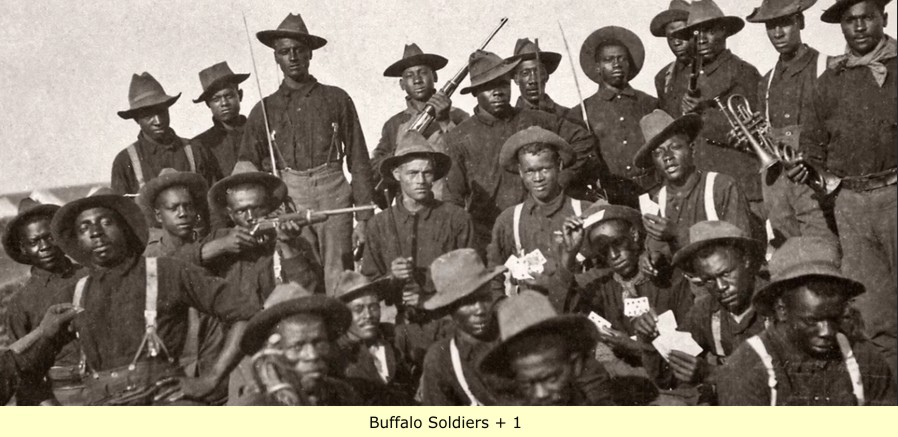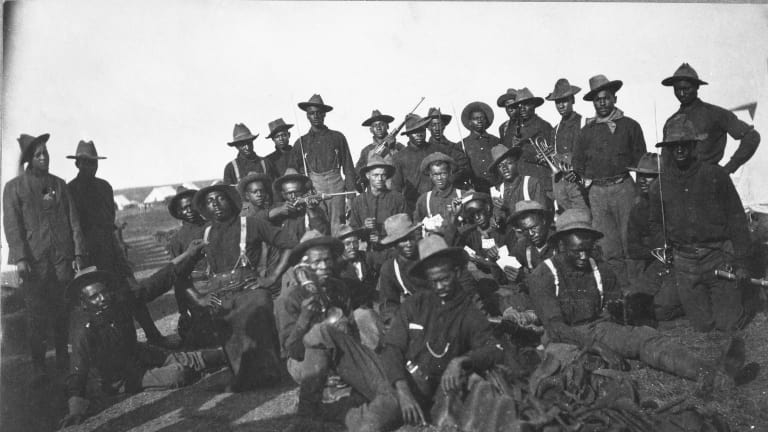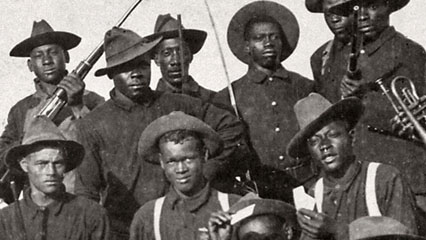
Buffalo soldiers were African American soldiers who mainly served on the Western frontier following the American Civil War. In 1866, six all-black cavalry and infantry regiments were created after Congress passed the Army Organization Act. Their main tasks were to help control the Native Americans of the Plains, capture cattle rustlers and thieves and protect settlers, stagecoaches, wagon trains and railroad crews along the Western front.
Who Were the Buffalo Soldiers?
No one knows for certain why, but the soldiers of the all-black 9th and 10th Cavalry Regiments were dubbed “buffalo soldiers” by the Native Americans they encountered.
One theory claims the nickname arose because the soldiers’ dark, curly hair resembled the fur of a buffalo. Another assumption is the soldiers fought so valiantly and fiercely that the Indians revered them as they did the mighty buffalo.
Whatever the reason, the name stuck, and African American regiments formed in 1866, including the 24th and 25th Infantry (which were consolidated from four regiments) became known as buffalo soldiers.
The 9th Cavalry Regiment
The mustering of the 9th Cavalry took place in New Orleans, Louisiana, in August and September of 1866. The soldiers spent the winter organizing and training until they were ordered to San Antonio, Texas, in April 1867. There they were joined by most of their officers and their commanding officer, Colonel Edward Hatch.
Training the inexperienced and mostly uneducated soldiers of the 9th Calvary was a challenging task. But the regiment was willing, able and mostly ready to face anything when they were ordered to the unsettled landscape of West Texas.
The soldiers’ main mission was to secure the road from San Antonio to El Paso and restore and maintain order in areas disrupted by Native Americans, many of whom were frustrated with life on Indian reservations and broken promises by the federal government.
The 10th Cavalry Regiment
The 10th Cavalry was based in Fort Leavenworth, Kansas, and commanded by Colonel Benjamin Grierson. Mustering was slow, partly because the colonel wanted more educated men in the regiment and partly because of a choleraoutbreak in the summer of 1867.
In August 1867, the regiment was ordered to Fort Riley, Kansas, with the task of protecting the Pacific Railroad, which was under construction at the time.
Before they left Fort Leavenworth, some troops fought hundreds of Cheyenne in two separate battles near the Saline River. With the support of the 38th Infantry Regiment—which was later consolidated into the 24th Infantry Regiment—the 10th Cavalry pushed back the hostile Indians.
The cavalry lost just one man and several horses despite having inferior equipment and being greatly outnumbered. It was just one of many battles to come.
Indian Wars
Both the 9th and 10th Cavalry Regiments participated in dozens upon dozens of skirmishes and larger battles of the Indian Wars.
For instance, the 9th Cavalry was critical to the success of a three-month, unremitting campaign known as the Red River War against the Kiowas, the Comanches, the Cheyenne and the Arapahoe. It was after this battle that the 10th Cavalry was sent to join them in Texas.
Troops H and I of the 10th Cavalry were part of a team that rescued wounded Lieutenant-Colonel George Alexander Forsyth and what remained of his group of scouts trapped on a sand bar and surrounded by Indians in the Arikaree River. A couple weeks later, the same troops engaged hundreds of Indians at Beaver Creek and fought so gallantly they were thanked in a field order by General Philip Sheridan.
By 1880, the 9th and 10th Cavalry Regiments had minimized Indian resistance in Texas and the 9th Cavalry was ordered to Indian Territory in modern-day Oklahoma, ironically to prevent white settlers from illegally settling on Indian land. The 10th Cavalry continued to keep the Apache in check until the early 1890s when they relocated to Montana to round up the Cree.
About 20 percent of U.S. Cavalry troops that participated in the Indian Wars were buffalo soldiers, who participated in at least 177 conflicts.
Buffalo Soldiers Protect National Parks
Buffalo soldiers didn’t only battle unfriendly Indians. They also fought wildfires and poachers in Yosemite and Sequoia National Parks and supported the parks’ infrastructure.
According to the National Park Service, buffalo soldiers billeted at the Presidio army post in San Francisco during the winter and served as park rangers in the Sierra Nevada in the summer.
Buffalo Soldiers in Other Conflicts
In the late 1890s, with the “Indian problem” mostly settled, the 9th and 10th Calvary and the 24th and 25th Infantry headed to Florida at the start of the Spanish-American War.
Even facing blatant racism and enduring brutal weather conditions, buffalo soldiers earned a reputation for serving courageously. They fought heroically in the Battle of San Juan Hill, the Battle of El Caney and the Battle of Las Guasimas.
The 9th and 10th Cavalry Regiments served in the Philippines in the early 1900s. Despite proving their military worth time and again, they continued to experience racial discrimination. During World War I, they were mostly relegated to defending the Mexican border.
Both regiments were integrated into the 2nd Cavalry Division in 1940. Neither saw action during World War II, although they trained for overseas deployment and combat. The 9th and 10th Cavalry Regiments were deactivated in May 1944.
Mark Matthews
In 1948, President Harry Truman issued an executive order eliminating racial segregation in America’s armed forces. The last all-black units were disbanded during the 1950s.
Mark Matthews, the nation’s oldest living buffalo soldier, died in 2005 at age 111 in Washington, D.C.
Buffalo soldiers had the lowest military desertion and court-martial rates of their time. Many won the Congressional Medal of Honor, an award presented in recognition of combat valor which goes above and beyond the call of duty.
Sources
9th Cavalry Regiment. 1st Cavalry Division Association.
Who Are The Buffalo Soldiers? Buffalo Soldier Museum.
9th Cavalry Regiment (1866-1944). Blackpast.org.
10th Cavalry Regiment (1866-1944). Blackpast.org.
Buffalo Soldiers. National Park Service.
Buffalo Soldiers and the Spanish-American War. National Park Service.
Exploring the Life and History of the “Buffalo Soldiers.” National Archives.
Ninth United States Cavalry. Texas State Historical Association.
The Ninth Regiment of Cavalry. U.S. Army Center of Military History.
The Tenth Regiment of Cavalry. U.S. Army Center of Military History.
World War I and the Buffalo Soldiers. National Park Service.











